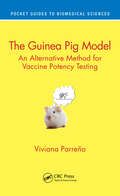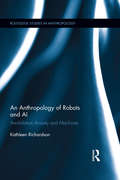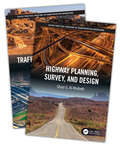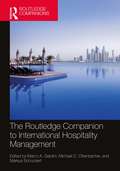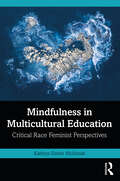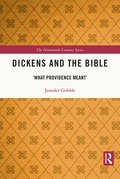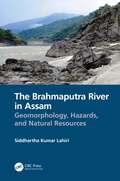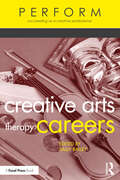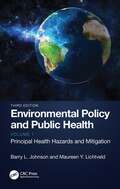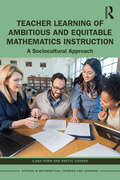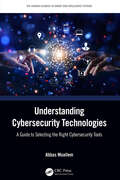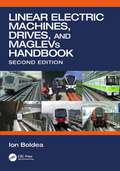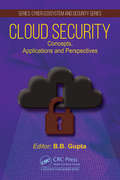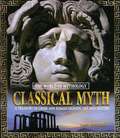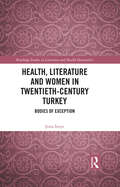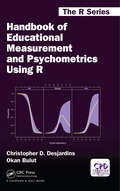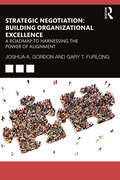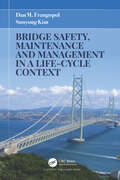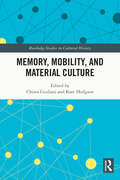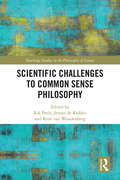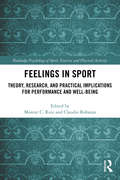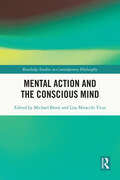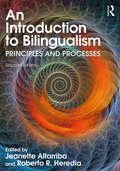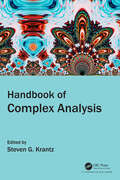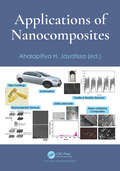- Table View
- List View
The Guinea Pig Model: An Alternative Method for Vaccine Potency Testing (Pocket Guides to Biomedical Sciences)
by Viviana ParreñoThis book summarizes the development and statistical validation of a guinea pig model as an alternative for potency testing of the viral antigens included in combined vaccines applied in cattle to control the respiratory, reproductive, and neonatal calf diarrhea syndromes. The model allows, in one serum sample, to test the vaccine quality for all the viral antigens included in aqueous as well as in oil-adjuvanted formulations of bovine vaccines. The methodology proposed for the control of bovine herpes virus, parainfluenza, and rotavirus were recommended by CAMEVET as guidelines for the 30 countries in the forum, including the US.Key Features Reviews combined vaccines used for cattle Summarizes animal models used for vaccine testing Focuses on bovine herpesviruses, rotaviruses, parainfluenza, and bovine viral diarrhea virus Provides guidance on the effectiveness of the Guinea Pig model for testing vaccine immunogenicity
An Anthropology of Robots and AI: Annihilation Anxiety and Machines (Routledge Studies in Anthropology)
by Kathleen RichardsonThis book explores the making of robots in labs at the Massachusetts Institute of Technology (MIT). It examines the cultural ideas that go into the making of robots, and the role of fiction in co-constructing the technological practices of the robotic scientists. The book engages with debates in anthropological theorizing regarding the way that robots are reimagined as intelligent, autonomous and social and weaved into lived social realities. Richardson charts the move away from the “worker” robot of the 1920s to the “social” one of the 2000s, as robots are reimagined as companions, friends and therapeutic agents.
Highway Planning, Survey, and Design
by Ghazi G. Al-KhateebHighway Planning, Survey, and Design presents the latest engineering concepts, techniques, practices, principles, standard procedures, and models that are applied and used to design and evaluate alternatives of transportation systems and roadway horizontal and vertical alignments and to forecast travel demand using variety of trip forecasting models to ultimately achieve greater safety, sustainability, efficiency, and cost-effectiveness. It provides in-depth coverage of the major areas of transportation engineering and includes a broad range of practical problems and solutions, related to theory, concepts, practice, and applications. Solutions for each problem follow step-by-step procedures that include the theory and the derivation of the formulas and computations where applicable. Additionally, numerical methods, linear algebraic methods, and least squares regression techniques are presented to assist in problem solving.Features: Presents coverage of major areas in transportation engineering: urban transportation planning, highway surveying, and geometric design of highways Provides solutions to numerous practical problems in transportation engineering including terminology, theory, practice, computation, and design Offers downloadable and user-friendly MS Excel spreadsheets as well as numerical methods and optimization tools and techniques Includes several practical case studies throughout Implements a unique approach in presenting the different topics Highway Planning, Survey, and Design will help academics and professionals alike to find practical solutions across the broad spectrum of transportation engineering issues.
The Routledge Companion to International Hospitality Management (ISSN)
by Marco A. GardiniThe hospitality sector is facing increasing competition and complexity over recent decades in its development towards a global industry. The strategic response to this is still that hospitality companies try to grow outside their traditional territories and domestic markets, while the expansion patterns and M&A activities of international hotel and restaurant chains reflect this phenomenon. Yet, interestingly, the strategies, concepts, and methods of internationalization as well as the managerial and organizational challenges and impacts of globalizing the hospitality business are under-researched in this industry.While the mainstream research on international management offers an abundance of information and knowledge on topics, players, trends, concepts, frameworks, or methodologies, its ability to produce viable insights for the hospitality industry is limited, as the mainstream research is taking place outside of the service sector. Specific research directions and related cases like the international dimensions of strategy, organization, marketing, sales, staffing, control, culture, and others to the hospitality industry are rarely identifiable so far. The core rationale of this book is therefore to present newest insights from research and industry in the field of international hospitality, drawing together recent scientific knowledge and state-of-the-art expertise to suggest directions for future work. It is designed to raise awareness on the international factors influencing the strategy and performance of hospitality organizations, while analyzing and discussing the present and future challenges for hospitality firms going or being international.This book will provide a comprehensive overview and deeper understanding of trends and issues to researchers, practitioners, and students by showing how to master current and future challenges when entering and competing in the global hospitality industry.
Mindfulness in Multicultural Education: Critical Race Feminist Perspectives
by Kathryn Esther McIntoshGrounded in critical race feminism, this book explores mindfulness as an empowering approach in multicultural education. The author explores how learners of multicultural education—by (re)centering the body through mindfulness with concrete strategies and scaffolded practice—can be empowered to handle the activated emotions and deep self-inquiry that come with the work of social justice, liberation, and anti-racism. This book includes counter stories of students of colors and offers both an epistemological and a curricular approach to mindfulness in multicultural education, including discussion of theory and key principles in addition to ten modules with practices to engage learners. These modules can be directly applied as the basis for curricular changes in teacher education and university-wide social justice courses, or they can be independently read by learners interested in enhancing their wellbeing and social justice. Written for teacher preparation and university social justice courses, this book encourages educators to contextualize their mindfulness practice within a critique of systems of oppression and ask questions about how mindfulness can empower action towards a more just society.
Dickens and the Bible: 'What Providence Meant' (ISSN)
by Jennifer GribbleAt a time when biblical authority was under challenge from the Higher Criticism and evolutionary science, ‘what providence meant’ was the most keenly contested of questions. This book takes up the controversial subject of Dickens and religion, and offers a significant contribution to the interdisciplinary area of religion and literature. In a close study of major novels, it argues that networks of biblical allusion reveal the Judeo-Christian grand narrative as key to his development as a writer, and as the ontological ground on which he stands to appeal to ‘the conscience of a Christian people’. Engaging the biblical narrative in dialogue with other contemporary narratives that concern themselves with origins, destinations, and hermeneutic decipherments, the inimitable Dickens affirms the Bible’s still-active role in popular culture. The providential thinking of two twentieth-century theorists, Bakhtin and Ricoeur, sheds light on an exploration of Dickens’s narrative theology.
The Brahmaputra River in Assam: Geomorphology, Hazards, and Natural Resources
by Siddhartha Kumar LahiriThis holistic book covers the richest area in North East India in terms of both explored and foreseen reserves of fossil fuels and other natural resources. Using a multidisciplinary approach, GIS, and geospatial data gathered from different case studies included, this book helps readers develop a thorough understanding of a highly dynamic big river, the Brahmaputra, and use it as a comprehensive resource for further understanding the science of rivers. It discusses the causal factors of decadal-scale fluvial dynamics, the nature of fluvial dynamics, lateral variability of the older flood plains and neotectonics in the shallow subsurface, and the overall trend of basin evolution at different depths.
Creative Arts Therapy Careers: Succeeding as a Creative Professional (ISSN)
by Sally BaileyCreative Arts Therapy Careers is a collection of essays written by and interviews with registered drama therapists, dance/movement therapists, music therapists, art therapists, poetry therapists, and expressive arts therapists.The book sheds light on the fascinating yet little-known field of the creative arts therapies – psychotherapy approaches which allow clients to use creativity and artistic expression to explore their lives, solve their problems, make meaning, and heal from their traumas. Featuring stories of educators in each of the six fields and at different stages of their career, it outlines the steps one needs to take in order to find training in one of the creative arts therapies and explores the healing aspects of the arts, where creative arts therapists work, who they work with, and how they use the arts in therapy. Contributors to this book provide a wealth of practical information, including ways to find opportunities to work with at-risk populations in order to gain experience with the arts as healing tools; choosing the right graduate school for further study; the difference between registration, certification, and licensure; and the differences between a career in a medical, mental health, educational, correctional, or service institution.This book illuminates creative arts therapy career possibilities for undergraduate and graduate students studying acting, directing, playwriting, creative writing, visual arts, theatre design, dance, and music. It is also an excellent resource for instructors offering a course to prepare arts students of all kinds for the professional world.
Environmental Policy and Public Health: Principal Health Hazards and Mitigation, Volume 1
by Barry L. Johnson Maureen Y. LichtveldWritten by environmental health experts with long teaching and professional careers in policy and public health, the third edition of Environmental Policy and Public Health comprises two volumes addressing key physical hazards in the environment that impact public health. The first volume on Principal Health Hazards and Mitigation is complemented by the second volume, Emerging Health Hazards and Mitigation. The health of the environment is inextricably linked to that of people. Thoroughly updated, Volume 1 describes how the quality of air, water, and food is threatened by the presence of toxic substances and explains why climate change is a global health priority already impacting human health and the environment. The mitigations discussed in this volume are twofold: policies that are intended for control of specific hazards and suggested hazard interventions. The role of policy in addressing each of these key environmental health areas is extensively discussed in this volume as well. Each chapter explains step by step how new environmental health issues are translated into public health policies and concludes with practice questions to facilitate interactive learning for upper-level undergraduate and graduate students taking courses in public health and environmental sciences. The step-by step approach, as well as the case studies and practice questions, allow for a diverse portfolio of in-person and hybrid pedagogical strategies and tools at the fingertips of faculty who not only teach policy courses, but whose course topics, such as climate and health, have policy relevance.
Teacher Learning of Ambitious and Equitable Mathematics Instruction: A Sociocultural Approach (Studies in Mathematical Thinking and Learning Series)
by Ilana Horn Brette GarnerDrawing on sociocultural learning theory, this book offers a groundbreaking theory of secondary mathematics teacher learning in schools, focusing on the transformation of instruction as a conceptual change project to achieve ambitious and equitable mathematics teaching.Despite decades of research showing the importance of ambitious and equitable teaching, few inroads have been made in most U.S. classrooms, and teacher learning in general remains undertheorized in most educational research. Illustrating their theory through closely documented case studies of secondary mathematics teachers’ learning and instructional practices, authors Horn and Garner explore the key conceptual issues teachers are required to work through in order to more fully realize ambitious and equitable teaching in their classrooms. By theorizing teacher learning from a sociocultural perspective and focusing on instructional practice, the authors make a unique contribution to the field of teacher learning.This book offers researchers, scholars, and teacher educators new theoretical and methodological tools for the elusive phenomenon of teacher learning, and provides instructional leaders and coaches with practical examples of how teachers shift their thinking and practice.
Understanding Cybersecurity Technologies: A Guide to Selecting the Right Cybersecurity Tools (The Human Element in Smart and Intelligent Systems)
by Abbas MoallemCyberattacks on enterprises, government institutions, and individuals are exponentially growing. At the same time, the number of companies, both small and large, offering all types of solutions has been increasing too. Since companies rely on technological solutions to protect themselves against cyberattacks, understanding and selecting the right solutions among those offered presents a significant challenge for professionals, company executives, and newcomers to the cybersecurity field.FEATURES Presents descriptions for each type of cybersecurity technology and their specifications Explains applications, usages, and offers case studies to enhance comprehension Offers an easy-to-understand classification of existing cybersecurity technologies Provides an understanding of the technologies without getting lost in technical details Focuses on existing technologies used in different solutions, without focusing on the companies that offer these technologies This book is intended to help all professionals new to cybersecurity, students, and experts to learn or educate their audiences on the foundations of the available solutions.
Linear Electric Machines, Drives, and MAGLEVs Handbook
by Ion BoldeaLinear motion is richly present in various industries, from direct electric propulsion in urban and interurban people movers on wheels or on magnetic “cushions” (MAGLEVs) to indoor transport of goods (conveyors, etc.), through plunger solenoids (to open hotel doors and as electromagnetic power switches), to compressor drives by linear oscillatory permanent magnet (PM) motors, smart phones integrated microphone and loudspeakers, and controlled vehicles’ suspension, etc. Besides the traditional rotary motor drives with mechanical transmissions, which mean friction limitations (weather dependent) in traction (heavy vehicles), more losses, positioning errors (backlash) in the process, and higher maintenance costs to handle them, linear motion in industry by direct electromagnetic forces is free of friction limitations for traction, free of mechanical transmission, and thus more efficient, with less maintenance cost and fewer positioning errors (backlash). This explains why they are used in so many applications already since the dramatic advancement of power electronics and digital control in the last four decades.Modeling, performance, design, control, and testing of linear electric machines (LEMs) show notable differences with respect to rotary electric motor drives, which warrant a dedicated treatment of these aspects.The Second Edition (First Edition: 2013) concentrates on the above technical aspects of various types of LEMs in close relationship with specific applications via numerical examples of modeling, design, control, and testing, with ample representative results from literature, industry and some of the author’s contributions, such as: Technical field and circuit modeling of linear induction motors in flat configurations for low and high speeds (with and without dynamic end effects) and in tubular configurations short travel design, control and testing Linear synchronous motor (LSM) drives in dc-excited, homopolar, reluctance and superconducting excitation configurations for urban and interurban high-speed vehicles propulsion and integrated propulsion and levitation (in MAGLEVs) modeling, design and control with full-scale numerical examples, with emphasis on lower KWh/passenger/Km at high speeds Flat and tubular linear permanent magnet (PM) synchronous motors (L-PMSMs), mainly destined to industrial indoor transport for automation at high efficiency in clean rooms Linear “flux-modulation” motors— new breed, suitable for very low-speed applications due to higher thrust density Plunger solenoids in various applications including new valve PM actuators with millisecond response time Linear resonant PM oscillatory motors design, control and testing mainly destined to compressors for higher efficiency in compact drives Attraction and repulsive force suspension (levitation) systems for MAGLEVs Active and passive guideway MAGLEVs in urban and superhigh-speed interurban transport at lower Kwh per passenger/km (in lighter vehicles without wheels) The numerous numerical design and control examples (with practical specifications) throughout the 23 chapters of the book allow the reader deep and fast access to a practical but thorough unitary (good for comparisons) methodology in designing and controlling LEMs for various applications.
Cloud Security: Concepts, Applications and Perspectives (Cyber Ecosystem and Security)
by Brij B GuptaCloud computing is an indispensable part of the modern Information and Communication Technology (ICT) systems. Cloud computing services have proven to be of significant importance, and promote quickly deployable and scalable IT solutions with reduced infrastructure costs. However, utilization of cloud also raises concerns such as security, privacy, latency, and governance, that keep it from turning into the predominant option for critical frameworks. As such, there is an urgent need to identify these concerns and to address them.Cloud Security: Concepts, Applications and Perspectives is a comprehensive work with substantial technical details for introducing the state-of-the-art research and development on various approaches for security and privacy of cloud services; novel attacks on cloud services; cloud forensics; novel defenses for cloud service attacks; and cloud security analysis. It discusses the present techniques and methodologies, and provides a wide range of examples and illustrations to effectively show the concepts, applications, and perspectives of security in cloud computing. This highly informative book will prepare readers to exercise better protection by understanding the motivation of attackers and to deal with them to mitigate the situation. In addition, it covers future research directions in the domain. This book is suitable for professionals in the field, researchers, students who are want to carry out research in the field of computer and cloud security, faculty members across universities, and software developers engaged in software development in the field.
Classical Myth: A Treasury of Greek and Roman Legends, Art, and History
by Jane BinghamThe World of Mythology series introduces the myths of the world's greatest civilizations. The Classical world of ancient Greece and Rome has had an immeasurable impact on Western culture, but what inspired some of the greatest writers, philosophers, and architects of all time? Gods were not only worshipped, but consulted for both minor problems and victory in battle. The legends of mortals Heracles and Perseus were wrapped up in the lives of the immortals. Art and artifacts, as well as photographs of the landscapes immortalized in the tales, bring the world of Classical myth to life.
Health, Literature and Women in Twentieth-Century Turkey: Bodies of Exception (Routledge Studies in Literature and Health Humanities)
by Şima İmşirHealth, Literature and Women in Twentieth-Century Turkey offers readers fresh insight into Turkish modernity and its discourse on health, what it excludes and how these potentialities manifest themselves in women’s fiction to shape the imagination of the period. Starting from the nineteenth century, health gradually became a focal topic in relation to the future of the empire, and later the Republic. Examining representations of health and illness in nationalist romances, melodramas and modernist works, this book will explore diseases such as syphilis, tuberculosis and cancer, and their representation in the literary imagination as a tool to discuss anxieties over cultural transformation. This book places Turkish literature in the field of health humanities and identifies the discourse on health as a key component in the making of the Turkish nation-building ideology. By focusing on the place of health and illness in canonical and non-canonised fiction, it opens a new field in Turkish literary studies.
Handbook of Educational Measurement and Psychometrics Using R (Chapman & Hall/CRC The R Series)
by Christopher D. Desjardins Okan BulutCurrently there are many introductory textbooks on educational measurement and psychometrics as well as R. However, there is no single book that covers important topics in measurement and psychometrics as well as their applications in R. The Handbook of Educational Measurement and Psychometrics Using R covers a variety of topics, including classical test theory; generalizability theory; the factor analytic approach in measurement; unidimensional, multidimensional, and explanatory item response modeling; test equating; visualizing measurement models; measurement invariance; and differential item functioning.This handbook is intended for undergraduate and graduate students, researchers, and practitioners as a complementary book to a theory-based introductory or advanced textbook in measurement. Practitioners and researchers who are familiar with the measurement models but need to refresh their memory and learn how to apply the measurement models in R, would find this handbook quite fulfilling. Students taking a course on measurement and psychometrics will find this handbook helpful in applying the methods they are learning in class. In addition, instructors teaching educational measurement and psychometrics will find our handbook as a useful supplement for their course.
Strategic Negotiation: A Roadmap to Harnessing The Power of Alignment
by Joshua Gordon Gary FurlongEmpowering organizations to thrive, this book provides a clear diagnostic framework with specific approaches and processes that leaders can use to build a negotiation function that will succeed each and every time.Negotiation is a required skill and a core competency, but most organizations focus exclusively on individual negotiation skills and abilities and pay little attention to the internal culture and environment that shapes and guides these individuals. This book takes a dramatically different approach to building success in each and every negotiation, producing results that align with organizational strategy at all levels.Professionals in sales, procurement and supply chain, human resources, change management, mergers and acquisitions, contracts, start-ups, construction partnering, and training consultants and students of business and law will value a text that understands how to build negotiation skills and capability across the organization by aligning individual skills with an evidence-based approach that actually works.
Bridge Safety, Maintenance and Management in a Life-Cycle Context
by Dan M. Frangopol Sunyong KimDuring the past two decades, it has been generally acknowledged that life-cycle bridge analysis can be a systematic tool to address efficient and effective bridge management under uncertainty life-cycle management at the bridge network level can lead to an improvement in the allocation of limited financial resources, ensuring the safety and functionality of the bridge network life-cycle management of bridges and bridge networks based on resilience and sustainability can improve their resistance and robustness to extreme events such as earthquakes, tsunamis, floods, and hurricanes bridge management should consider the impact of environmental conditions and climate change This book addresses important concepts and approaches developed recently on bridge safety, maintenance, and management in a life-cycle context. Bridge life-cycle performance and cost analysis, prediction, optimization, and decision making under uncertainty are discussed. The major topics include bridge safety and service life prediction; bridge inspection and structural health monitoring; bridge maintenance; life-cycle bridge and bridge network management; optimum life-cycle bridge management planning; resilience and sustainability of bridges and bridge networksunder hazards; and bridge management considering climate change. By providing practical applications of the presented concepts and approaches, this book can help students, researchers, practitioners, infrastructure owners and managers, and transportation officials to build up their knowledge of life-cycle bridge performance and cost management at bothproject level and network level under various deteriorating mechanisms, hazards and climate change effects.
Memory, Mobility, and Material Culture (Routledge Studies in Cultural History)
by Chiara Giuliani Kate HodgsonWith a focus on the object and where it is situated, in time (memory) and space (mobility), Memory, Mobility, and Material Culture embodies a multidisciplinary and cross-disciplinary approach.The chapters track the movement of the objects and their owner(s), within and between continents, countries, cities, and families. Objects have always been considered with an eye to their worth – economic, aesthetic, and/or functional. If that worth is diminished, their meaning and value disappear, they are just things. Yet things can still fulfil functions in our daily lives; they hold symbolic potential, from personal memory triggers, to focal points of public ritual and religion; from collectors’ obsession, to symbols of loss, displacement, and violence. By bringing into dialogue the work of specialists in ethnology, art history, architecture, and design; literature, languages, cultures, and heritage studies, this volume considers how displaced memory – the memory of refugees, migrants, and their descendants; of those who have moved from the countryside to the city; of those who have faced personal upheaval and profound social change; those who have been forced into exile or experienced major personal or collective loss – can become embodied in material culture. This book is important reading to those interested in cultural and social history and cultural studies.
Scientific Challenges to Common Sense Philosophy (Routledge Studies in the Philosophy of Science)
by Rik Peels; Jeroen de Ridder; René van WoudenbergCommon sense philosophy holds that widely and deeply held beliefs are justified in the absence of defeaters. While this tradition has always had its philosophical detractors who have defended various forms of skepticism or have sought to develop rival epistemological views, recent advances in several scientific disciplines claim to have debunked the reliability of the faculties that produce our common sense beliefs. At the same time, however, it seems reasonable that we cannot do without common sense beliefs entirely. Arguably, science and the scientific method are built on, and continue to depend on, common sense.This collection of essays debates the tenability of common sense in the face of recent challenges from the empirical sciences. It explores to what extent scientific considerations—rather than philosophical considerations—put pressure on common sense philosophy. The book is structured in a way that promotes dialogue between philosophers and scientists. Noah Lemos, one of the most influential contemporary advocates of the common sense tradition, begins with an overview of the nature and scope of common sense beliefs, and examines philosophical objections to common sense and its relationship to scientific beliefs. Then, the volume features essays by scientists and philosophers of science who discuss various proposed conflicts between commonsensical and scientific beliefs: the reality of space and time, about the nature of human beings, about free will and identity, about rationality, about morality, and about religious belief. Notable philosophers who embrace the common sense tradition respond to these essays to explore the connection between common sense philosophy and contemporary debates in evolutionary biology, neuroscience, physics, and psychology.
Feelings in Sport: Theory, Research, and Practical Implications for Performance and Well-being (Routledge Psychology of Sport, Exercise and Physical Activity)
by Montse Ruiz Claudio RobazzaFeeling states, including emotional experiences, are pervasive to human functioning. Feeling states deeply influence the individual’s effort, attention, decision making, memory, behavioural responses, and interpersonal interactions. The sporting environment offers an ideal setting for the development of research questions and applied interventions to improve the well-being and well-functioning of the people involved. This ground-breaking book is the first to offer cutting-edge knowledge about contemporary theoretical, methodological, and applied issues with the contributions of leading researchers and practitioners in the field. Feeling states in sports are comprehensively covered by adopting an international and multi-disciplinary perspective. Part I covers most relevant conceptual frameworks, including emotion-centred and action-centred approaches, challenge and threat evaluations, an evolutionary approach to emotions, and the role of passion in the experience of emotion. Part II focuses on interpersonal aspects related to emotions and regulation, encompassing social and interpersonal emotion influence and regulation, social identity and group-based emotions, and performance experiences in teams. Part III presents applied indications surrounding emotional intelligence training, and emotional regulation strategies including imagery, self-talk, the use of music, mindfulness, motor skills execution under pressure, self-regulation in endurance sports, and the use of technology. Finally, Part IV examines issues related to athlete well-being, including the role of emotions in sport injury, emotional eating, and mental recovery. Feelings in Sport: Theory, Research, and Practical Implications for Performance and Well-being is an essential source for sport psychology practitioners, researchers, sports coaches, undergraduate and postgraduate students.
Mental Action and the Conscious Mind (Routledge Studies in Contemporary Philosophy)
by Michael BrentMental action deserves a place among foundational topics in action theory and philosophy of mind. Recent accounts of human agency tend to overlook the role of conscious mental action in our daily lives, while contemporary accounts of the conscious mind often ignore the role of mental action and agency in shaping consciousness. This collection aims to establish the centrality of mental action for discussions of agency and mind. The thirteen original essays provide a wide-ranging vision of the various and nuanced philosophical issues at stake. Among the questions explored by the contributors are: Which aspects of our conscious mental lives are agential? Can mental action be reduced to and explained in terms of non-agential mental states, processes, or events? Must mental action be included among the ontological categories required for understanding and explaining the conscious mind more generally? Does mental action have implications for related topics, such as attention, self-knowledge, self-control, or the mind-body problem? By investigating the nature, scope, and explanation of mental action, the essays presented here aim to demonstrate the significance of conscious mental action for discussions of agency and mind. Mental Action and the Conscious Mind will be of interest to scholars and graduate students working in philosophy of mind, philosophy of action, and philosophy of agency, as well as to philosophically inclined cognitive scientists.
An Introduction to Bilingualism: Principles and Processes
by Jeanette Altarriba and Roberto R. HerediaThe study of bilingualism and all of its aspects – from theory and models to social approaches and their practical applications – forms the cornerstone of the 2nd edition of this work. The chapters cover the latest advancements in the domains of psycholinguistics, neuroscience, creativity, and executive functioning. Contributions, new to this edition, offer the reader the most up-to-date research on lifespan and developmental issues. The work also provides insight into how human language is processed by all, not just by bilingual and multilingual speakers.This text is ideal for senior undergraduate and graduate courses in psycholinguistics and the psychology of language, especially those with an emphasis on bilingualism or second language learning.
Handbook of Complex Analysis
by Steven G. KrantzIn spite of being nearly 500 years old, the subject of complex analysis is still today a vital and active part of mathematics. There are important applications in physics, engineering, and other aspects of technology. This Handbook presents contributed chapters by prominent mathematicians, including the new generation of researchers. More than a compilation of recent results, this book offers students an essential stepping-stone to gain an entry into the research life of complex analysis. Classes and seminars play a role in this process. More, though, is needed for further study. This Handbook will play that role. This book is also a reference and a source of inspiration for more seasoned mathematicians—both specialists in complex analysis and others who want to acquaint themselves with current modes of thought.The chapters in this volume are authored by leading experts and gifted expositors. They are carefully crafted presentations of diverse aspects of the field, formulated for a broad and diverse audience. This volume is a touchstone for current ideas in the broadly construed subject area of complex analysis. It should enrich the literature and point in some new directions.
Applications of Nanocomposites
by Ahalapitiya H. JayatissaIn this book, different applications of nanomaterials are described based on experiments, validations, and prototype manufacturing. It also covers synthesis, characterization, functionalization and coating of nanomaterials in various application-oriented investigations. The use of nanomaterials in energy storage, catalyst preparation and tribology are a few examples of improving the efficiency of future technologies. In addition, this book has also contributed to the nanomanufacturing of composites for automobile industries, glass industries, textiles and flexible electronics. This book provides knowledge on multiple related fields in applying nanomaterials, emphasizing the most updated literature, understanding applications, and consists of examples and illustrations so that readers can absorb the content rapidly.
